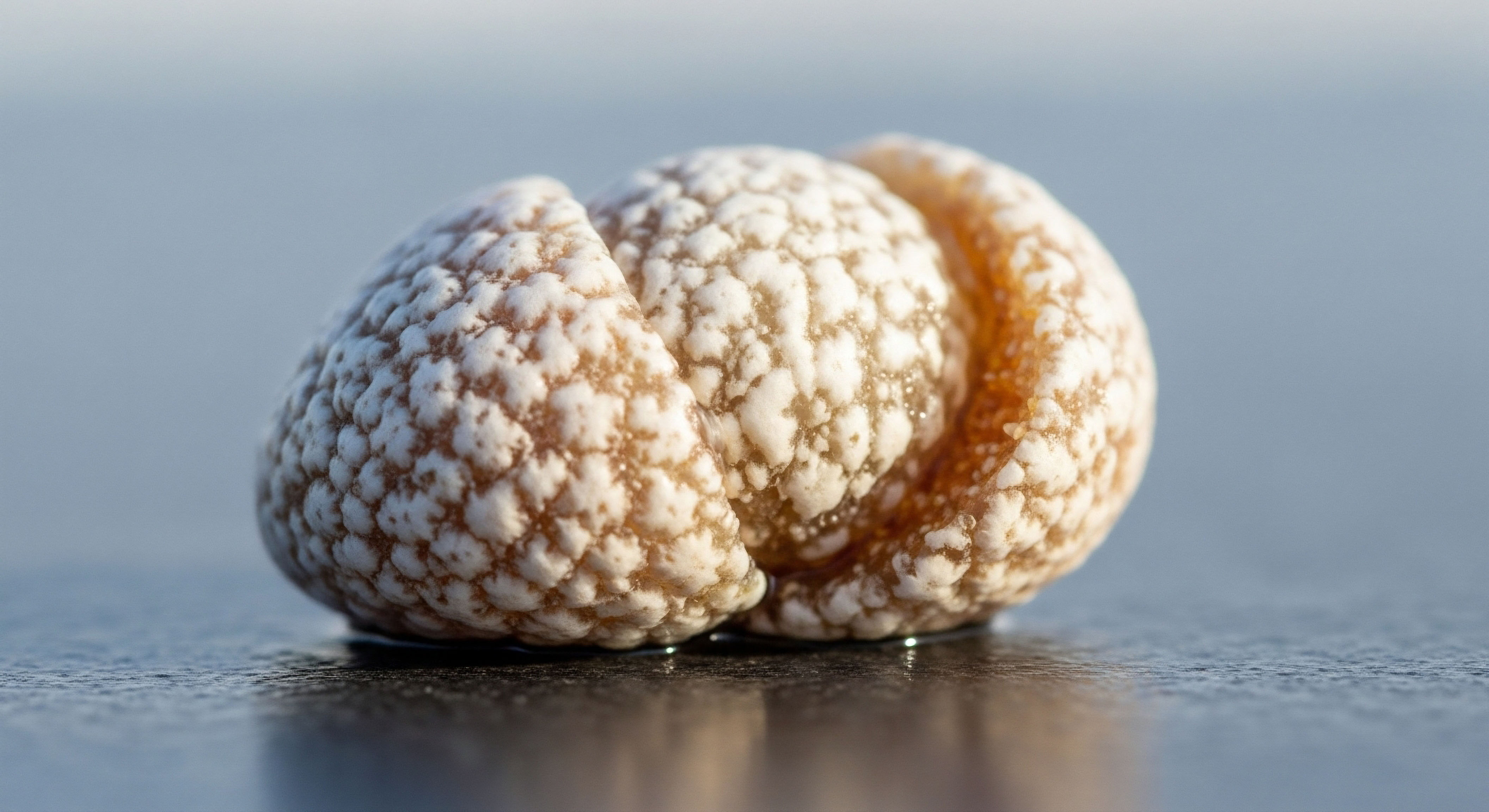

Fundamentals
Experiencing changes in hair texture, density, or growth patterns can be a deeply unsettling experience, often sparking concern about underlying health shifts. You might notice more strands on your pillow, a widening part, or a general thinning that wasn’t present before.
This personal observation, while seemingly isolated, frequently signals a deeper conversation occurring within your body’s intricate messaging network ∞ the endocrine system. The connection between how your hair behaves and the subtle shifts in your internal biochemistry is far more profound than many realize.
Hair follicles, those tiny organs responsible for hair production, are remarkably sensitive to hormonal fluctuations. They possess receptors for various hormones, including androgens, estrogens, and thyroid hormones. When these biochemical messengers are out of their optimal balance, the hair growth cycle can be disrupted, leading to noticeable alterations. This disruption is not merely cosmetic; it is a visible manifestation of systemic imbalances that warrant careful consideration.
Hair changes often serve as early indicators of deeper endocrine system imbalances, reflecting the body’s internal biochemical dialogue.
Understanding the fundamental role of hormones in regulating physiological processes is the initial step toward reclaiming vitality. Hormones act as the body’s internal communication network, orchestrating everything from metabolism and mood to reproductive function and, critically, hair health. When this communication becomes garbled or insufficient, a cascade of effects can ensue, with hair changes serving as one of the more apparent signs.

The Endocrine System and Hair Cycle
The endocrine system comprises a collection of glands that produce and secrete hormones directly into the bloodstream. These hormones then travel to target cells and organs, eliciting specific responses. Key players influencing hair health include the thyroid gland, adrenal glands, and gonads (testes in men, ovaries in women). Each of these glands contributes to a delicate hormonal equilibrium that supports the hair growth cycle.
Hair growth occurs in a cyclical pattern, consisting of three primary phases:
- Anagen ∞ The active growth phase, lasting several years.
- Catagen ∞ A transitional phase where growth stops, lasting a few weeks.
- Telogen ∞ The resting phase, after which the hair sheds, lasting a few months.
Disruptions to hormonal balance can prematurely shorten the anagen phase or push a disproportionate number of follicles into the telogen phase, resulting in increased shedding and reduced hair density. For instance, imbalances in thyroid hormones, specifically an underactive thyroid (hypothyroidism) or an overactive thyroid (hyperthyroidism), can significantly impact hair follicles, leading to diffuse hair loss across the scalp.

Dietary Foundations for Hormonal Balance
Considering dietary interventions as a standalone solution for significant hair changes linked to endocrine system support requires a nuanced perspective. While diet alone may not fully correct severe hormonal dysregulation, it forms the bedrock upon which all other interventions are built. Nutritional components provide the raw materials and regulatory signals necessary for hormone synthesis, metabolism, and cellular function.
A diet rich in specific micronutrients and macronutrients can support the body’s innate capacity for hormonal equilibrium. This foundational approach aims to optimize the internal environment, making it more receptive to, or even reducing the need for, more targeted endocrine system support. The body’s ability to produce and utilize hormones efficiently is inextricably linked to the quality and composition of its nutritional intake.

Macronutrient Balance and Hormonal Signaling
The balance of proteins, fats, and carbohydrates profoundly influences hormonal signaling. Adequate protein intake provides the amino acid building blocks for peptide hormones and enzymes involved in hormone synthesis. Healthy fats, particularly monounsaturated and polyunsaturated varieties, are crucial for the production of steroid hormones like testosterone and estrogen, as well as for maintaining cellular membrane integrity, which is vital for hormone receptor function.
Carbohydrates, in their complex, fiber-rich forms, play a role in blood sugar regulation, which directly impacts insulin and cortisol levels. Chronic fluctuations in blood sugar can lead to insulin resistance, a state where cells become less responsive to insulin. This condition can indirectly affect hair health by altering androgen metabolism, potentially contributing to androgenetic alopecia in susceptible individuals.

Micronutrients as Endocrine Cofactors
Beyond macronutrients, a spectrum of vitamins and minerals serves as essential cofactors for enzymatic reactions throughout the endocrine system. Deficiencies in these micronutrients can impede hormone production, conversion, and receptor sensitivity.
Key micronutrients for hair and hormonal health include:
- Zinc ∞ Involved in thyroid hormone metabolism, immune function, and regulation of androgen receptors. Zinc deficiency has been linked to various forms of hair loss.
- Selenium ∞ Essential for thyroid hormone synthesis and antioxidant defense, protecting thyroid tissue from oxidative stress.
- Iron ∞ Iron deficiency anemia is a common cause of hair shedding, particularly in women, as iron is vital for cellular proliferation in the hair follicle.
- Vitamin D ∞ Functions as a steroid hormone, influencing hair follicle cycling and immune regulation. Low vitamin D levels are frequently observed in individuals experiencing hair loss.
- B Vitamins (especially Biotin, B6, B12, Folate) ∞ Critical for cellular metabolism, energy production, and red blood cell formation, all of which indirectly support hair follicle health.
- Magnesium ∞ Involved in over 300 enzymatic reactions, including those related to stress hormone regulation and insulin sensitivity.
While dietary interventions alone may not reverse advanced hormonal conditions, they establish a robust physiological foundation. Optimizing nutrient intake can enhance the body’s resilience, improve hormonal communication, and potentially mitigate some hair changes. This approach is not a standalone cure for significant endocrine dysfunction, but rather an indispensable partner in any comprehensive wellness protocol.


Intermediate
When considering whether dietary interventions alone can significantly alter hair changes during endocrine system support, it becomes apparent that while nutrition is foundational, targeted clinical protocols often provide the necessary precision for meaningful change. Dietary adjustments lay the groundwork, optimizing the body’s internal environment, yet specific hormonal recalibration frequently requires direct intervention. This section explores how dietary strategies integrate with, and support, established endocrine system therapies, particularly those addressing sex hormone imbalances and growth hormone optimization.
The endocrine system operates through intricate feedback loops, akin to a sophisticated thermostat system regulating the body’s internal temperature. When one component is out of balance, it sends signals that can disrupt the entire network. Hair changes, in this context, are often a visible symptom of these systemic communication breakdowns. Addressing these breakdowns effectively often involves a multi-pronged approach that combines precise medical interventions with diligent nutritional support.
Dietary strategies are crucial supportive elements, but targeted clinical protocols often provide the precision needed for significant hair changes during endocrine system support.

Testosterone Optimization and Hair Health
Testosterone, a primary androgen, plays a complex role in hair health. While often associated with male pattern baldness, optimal testosterone levels are essential for overall vitality in both men and women, influencing hair follicle health in various ways. Imbalances, whether too high or too low, can contribute to hair thinning or loss.

Testosterone Replacement Therapy for Men
For men experiencing symptoms of low testosterone, such as reduced libido, fatigue, and muscle loss, Testosterone Replacement Therapy (TRT) is a common intervention. The standard protocol often involves weekly intramuscular injections of Testosterone Cypionate (typically 200mg/ml). While TRT aims to restore systemic testosterone levels, its impact on hair can be variable and requires careful management.
Dietary considerations for men on TRT focus on supporting metabolic health and managing potential side effects. A diet that minimizes processed foods, refined sugars, and excessive saturated fats can help mitigate the risk of insulin resistance and inflammation, which can indirectly influence androgen metabolism. Adequate intake of cruciferous vegetables, for example, can support healthy estrogen metabolism, which is important given that testosterone can convert to estrogen.
To maintain natural testosterone production and fertility, men on TRT often receive Gonadorelin, administered as 2x/week subcutaneous injections. This peptide stimulates the pituitary gland to release luteinizing hormone (LH) and follicle-stimulating hormone (FSH). Dietary support for Gonadorelin’s efficacy might include nutrients that support pituitary function, such as zinc and magnesium.
Another common component is Anastrozole, an aromatase inhibitor, typically taken as a 2x/week oral tablet to block the conversion of testosterone to estrogen. Managing estrogen levels is crucial, as elevated estrogen can contribute to hair thinning in some men. Dietary strategies that support liver detoxification pathways, such as a diet rich in antioxidants and sulfur-containing compounds, can complement the action of Anastrozole by aiding in estrogen excretion.
Some protocols may also include Enclomiphene to further support LH and FSH levels, particularly for men concerned with fertility preservation. Nutritional support for this aspect would align with general endocrine health, emphasizing a broad spectrum of vitamins and minerals.

Testosterone Optimization for Women
Women, too, can experience symptoms from suboptimal testosterone levels, particularly during peri-menopause and post-menopause. These symptoms can include irregular cycles, mood changes, hot flashes, and reduced libido. For women, testosterone protocols are typically lower dose, often involving Testosterone Cypionate at 10 ∞ 20 units (0.1 ∞ 0.2ml) weekly via subcutaneous injection.
The impact of testosterone on female hair can be particularly sensitive. While low testosterone can contribute to diffuse thinning, excessive androgen activity can lead to androgenetic alopecia, characterized by thinning at the crown and temples. Dietary interventions here are critical for modulating androgen sensitivity and metabolism. A diet low in refined carbohydrates and high in healthy fats and lean proteins can help manage insulin sensitivity, which is often intertwined with androgen excess in conditions like Polycystic Ovary Syndrome (PCOS).
Progesterone is prescribed based on menopausal status, playing a vital role in balancing estrogen and supporting the hair growth cycle. Dietary support for progesterone production includes adequate cholesterol intake (from healthy fats) and micronutrients like Vitamin C and B6.
Pellet Therapy, offering long-acting testosterone, may also be used, sometimes with Anastrozole when appropriate for estrogen management. The principles of dietary support remain consistent ∞ optimize metabolic health, support liver function, and ensure micronutrient sufficiency.

Growth Hormone Peptide Therapy and Hair Vitality
Growth hormone (GH) and its stimulating peptides play a significant role in cellular regeneration, including that of hair follicles. These therapies are often sought by active adults and athletes for anti-aging benefits, muscle gain, fat loss, and sleep improvement.
Key peptides include:
- Sermorelin ∞ A growth hormone-releasing hormone (GHRH) analog that stimulates the pituitary to produce and secrete GH.
- Ipamorelin / CJC-1295 ∞ These peptides also stimulate GH release, with Ipamorelin being a selective GH secretagogue and CJC-1295 (with DAC) providing a longer-acting effect.
- Tesamorelin ∞ A GHRH analog primarily used for visceral fat reduction, but with systemic benefits.
- Hexarelin ∞ A potent GH secretagogue.
- MK-677 ∞ An oral GH secretagogue that stimulates GH release.
While these peptides directly influence GH levels, dietary interventions significantly enhance their efficacy and overall impact on hair health. A diet rich in amino acids, particularly arginine and glutamine, can support endogenous GH production and cellular repair processes. Adequate sleep, supported by dietary choices that promote melatonin production (e.g. tart cherries, walnuts), also synergizes with GH peptide therapy, as GH is primarily released during deep sleep.
Consider the following table outlining dietary support for specific hormonal pathways:
| Hormonal Pathway / Therapy | Key Dietary Support | Mechanism of Action |
|---|---|---|
| Testosterone Optimization (Men) | Healthy fats (avocado, olive oil), lean protein, cruciferous vegetables, zinc-rich foods (oysters, beef) | Provides cholesterol for steroid hormone synthesis, supports estrogen metabolism, acts as cofactor for androgen receptors. |
| Testosterone Optimization (Women) | Balanced macronutrients, anti-inflammatory foods, spearmint tea (for androgen excess), flax seeds | Modulates insulin sensitivity, reduces inflammation, influences androgen receptor activity. |
| Thyroid Function | Iodine (seaweed, iodized salt), selenium (Brazil nuts), zinc, tyrosine (protein sources) | Essential for thyroid hormone synthesis and conversion, protects thyroid gland. |
| Growth Hormone Peptides | Amino acids (arginine, glutamine), adequate protein, sleep-promoting foods | Provides building blocks for GH, supports cellular repair, optimizes natural GH release. |
Dietary interventions, when strategically aligned with targeted endocrine system support, amplify the potential for positive hair changes. They are not merely supplementary; they are integral to creating an optimal internal environment where therapeutic protocols can yield their most beneficial effects. The synergy between precise biochemical recalibration and comprehensive nutritional strategies represents a powerful path toward restoring hair vitality.


Academic
The question of whether dietary interventions alone can significantly alter hair changes during endocrine system support necessitates a deep dive into the intricate molecular and physiological mechanisms governing hair follicle biology and hormonal regulation. While the foundational role of nutrition is undeniable, the complexity of endocrine signaling often requires targeted pharmacological or peptide-based interventions to achieve substantial and sustained alterations in hair phenotype.
This section dissects the interplay between dietary components, specific hormonal axes, and the hair growth cycle at a cellular and systemic level, demonstrating why a synergistic approach is often paramount.
Hair follicles are highly dynamic mini-organs, exhibiting one of the highest rates of cellular proliferation in the body. Their activity is exquisitely sensitive to systemic cues, particularly those from the endocrine system. Disruptions to the delicate balance of hormones can profoundly impact the stem cell niche within the follicle, altering the duration of the anagen phase, inducing premature catagen, or prolonging telogen, ultimately leading to visible hair thinning or loss.

The Hypothalamic-Pituitary-Gonadal Axis and Hair Follicle Dynamics
The Hypothalamic-Pituitary-Gonadal (HPG) axis represents a central regulatory pathway for sex steroid hormones, which are potent modulators of hair growth. The hypothalamus secretes gonadotropin-releasing hormone (GnRH), stimulating the pituitary gland to release luteinizing hormone (LH) and follicle-stimulating hormone (FSH). These gonadotropins, in turn, act on the gonads to produce testosterone, estrogen, and progesterone.
In the context of hair, the local metabolism of androgens within the hair follicle is particularly critical. Testosterone can be converted to the more potent androgen, dihydrotestosterone (DHT), by the enzyme 5-alpha-reductase. High local concentrations of DHT in genetically predisposed individuals can lead to follicular miniaturization, a hallmark of androgenetic alopecia. Conversely, insufficient androgen signaling can also contribute to diffuse hair thinning.
Dietary interventions can indirectly influence the HPG axis and local androgen metabolism. For instance, chronic insulin resistance, often driven by diets high in refined carbohydrates, can increase ovarian androgen production in women, contributing to hyperandrogenism and associated hair loss patterns. Dietary patterns that stabilize blood glucose and improve insulin sensitivity, such as a low-glycemic load diet, can therefore modulate this pathway.
Consider the role of specific dietary components:
- Phytoestrogens ∞ Compounds found in plants like lignans (flax seeds) and isoflavones (soy) can weakly bind to estrogen receptors and may influence androgen metabolism, potentially offering a mild anti-androgenic effect.
- Zinc ∞ Acts as an inhibitor of 5-alpha-reductase activity, thereby reducing DHT conversion. Dietary zinc intake, while important, may not be sufficient to counteract significant enzymatic overexpression.
- Omega-3 Fatty Acids ∞ Possess anti-inflammatory properties that can mitigate chronic low-grade inflammation, which can negatively impact hair follicle health and overall endocrine function.
While these dietary strategies offer supportive mechanisms, they typically do not possess the potency of pharmacological agents like finasteride (a 5-alpha-reductase inhibitor) or targeted hormonal therapies in significantly altering hair changes driven by pronounced HPG axis dysregulation.

Thyroid Hormones and Hair Follicle Homeostasis
The thyroid axis, regulated by the Hypothalamic-Pituitary-Thyroid (HPT) axis, is another critical determinant of hair health. Thyroid hormones, primarily thyroxine (T4) and triiodothyronine (T3), are essential for cellular metabolism and differentiation, including the proliferation of hair matrix cells. Both hypothyroidism (underactive thyroid) and hyperthyroidism (overactive thyroid) can lead to diffuse hair loss, often characterized by a generalized thinning of the scalp hair.
Dietary interventions play a direct role in supporting thyroid function. Adequate intake of iodine is fundamental for thyroid hormone synthesis, as iodine is a structural component of T4 and T3. Selenium is also crucial, as it is a cofactor for deiodinase enzymes that convert T4 to the more active T3, and it protects the thyroid gland from oxidative damage.
However, even with optimal dietary intake of these micronutrients, severe thyroid dysfunction often requires exogenous thyroid hormone replacement (e.g. levothyroxine) to restore euthyroid status and reverse associated hair changes. Dietary strategies alone are generally insufficient to correct overt thyroid pathology.

The Somatotropic Axis and Hair Regeneration
The somatotropic axis, involving growth hormone (GH) and insulin-like growth factor 1 (IGF-1), also influences hair follicle cycling. GH and IGF-1 promote cellular proliferation and differentiation, which are vital for the anagen phase of hair growth. Deficiencies in GH can lead to various dermatological manifestations, including hair thinning.
Peptide therapies, such as Sermorelin or Ipamorelin/CJC-1295, directly stimulate the pituitary gland to release endogenous GH, thereby increasing systemic IGF-1 levels. This direct stimulation offers a more potent and predictable increase in GH/IGF-1 signaling compared to dietary approaches alone. While certain amino acids (e.g. arginine, ornithine) can acutely stimulate GH release, their long-term impact on sustained GH levels and hair growth is limited compared to targeted peptide administration.
The synergy between dietary support and these interventions is critical. For instance, a diet that optimizes protein intake provides the necessary amino acid precursors for GH and IGF-1 synthesis, enhancing the body’s responsiveness to peptide therapy. Additionally, managing insulin sensitivity through diet is important, as high insulin levels can suppress GH secretion.

Hair Follicle Response to Hormonal and Nutritional Cues
The hair follicle itself is a complex mini-organ with distinct compartments, each responding to specific hormonal and nutritional signals. The dermal papilla, a cluster of mesenchymal cells at the base of the follicle, plays a central role in regulating hair growth through paracrine signaling with the epithelial cells of the hair matrix.
Consider the intricate interplay:
- Androgen Receptors ∞ Present in dermal papilla cells, mediating the effects of DHT on follicular miniaturization.
- Estrogen Receptors ∞ Also found in follicles, influencing the anagen phase duration and hair density.
- Thyroid Hormone Receptors ∞ Essential for the metabolic activity and proliferation of hair matrix cells.
- Growth Factor Receptors ∞ Including IGF-1 receptors, promoting cell survival and proliferation.
Dietary interventions alone can provide essential cofactors and modulators, but they typically operate at a systemic, supportive level. They optimize the internal milieu, making the body more receptive to, and potentially reducing the dosage requirements of, targeted endocrine therapies.
However, for significant alterations in hair changes stemming from pronounced hormonal dysregulation, direct endocrine system support, whether through hormone replacement or peptide therapy, often provides the necessary therapeutic leverage. The precision of these interventions, combined with a meticulously optimized nutritional foundation, offers the most comprehensive strategy for restoring hair vitality.
The following table illustrates the comparative impact of dietary versus targeted interventions on hair-related hormonal pathways:
| Hormonal Pathway | Dietary Intervention Impact on Hair | Targeted Endocrine Support Impact on Hair | Synergistic Outcome |
|---|---|---|---|
| Androgen Metabolism | Modulates insulin sensitivity, provides 5-alpha-reductase inhibitors (e.g. zinc), supports estrogen metabolism. Generally supportive, mild impact. | Directly blocks DHT conversion (finasteride), provides exogenous testosterone (TRT) to optimize systemic levels, manages estrogen with aromatase inhibitors. Significant, direct impact. | Optimized androgen balance, reduced follicular miniaturization, improved hair density. |
| Thyroid Function | Provides iodine, selenium, tyrosine for hormone synthesis and conversion. Essential cofactors, but limited for overt dysfunction. | Exogenous thyroid hormone replacement (levothyroxine) to restore euthyroid state. Direct and potent correction of deficiency. | Restored hair growth cycle, reduced diffuse shedding, improved hair texture. |
| Growth Hormone/IGF-1 | Provides amino acid precursors, supports sleep. Indirect, mild influence on endogenous GH release. | GH-releasing peptides (Sermorelin, Ipamorelin) directly stimulate pituitary GH secretion. Potent, direct increase in anabolic signaling. | Enhanced cellular regeneration in follicles, prolonged anagen phase, improved hair thickness. |
Can a diet alone significantly alter hair changes during endocrine system support? The academic perspective suggests that while dietary interventions are indispensable for creating an optimal physiological environment and providing essential cofactors, they are rarely sufficient as standalone solutions for significant hair changes driven by clinical endocrine imbalances. The precision and potency of targeted hormonal or peptide therapies often provide the necessary impetus for substantial alterations, with diet serving as a powerful, synergistic partner.

References
- Brzezińska-Wcisło, M. (2001). “The influence of thyroid hormones on hair growth.” Dermatologia Kliniczna, 3(1), 1-5.
- Yip, L. et al. (2011). “The relationship between insulin resistance and androgenetic alopecia in women.” Journal of the American Academy of Dermatology, 65(6), 1132-1138.
- Park, H. et al. (2009). “The effect of zinc supplementation on hair loss in patients with chronic telogen effluvium.” Dermatologic Therapy, 22(6), 558-562.
- Rushton, D. H. (2002). “Nutritional factors and hair loss.” Clinical and Experimental Dermatology, 27(5), 396-404.
- Saini, K. et al. (2018). “Vitamin D and hair loss ∞ a review.” International Journal of Trichology, 10(3), 103-107.
- Messenger, A. G. & Rundegren, J. (2001). “Androgenetic alopecia ∞ an update of pathogenesis and management.” Clinical and Experimental Dermatology, 26(3), 205-212.
- Azziz, R. (2003). “The polycystic ovary syndrome ∞ current concepts in pathogenesis and therapy.” Journal of Clinical Endocrinology & Metabolism, 88(6), 2389-2401.
- Touillaud, M. S. et al. (2007). “Lignans and isoflavonoids in plasma and breast cancer risk in a prospective cohort of women (EPIC-France).” Cancer Epidemiology, Biomarkers & Prevention, 16(6), 1224-1232.
- Wessells, K. R. & Singh, P. K. (2018). “The role of zinc in hair loss ∞ a review of the literature.” Journal of Clinical and Aesthetic Dermatology, 11(10), 28-33.
- Le Floc’h, C. & Cheniti, A. (2019). “The role of omega-3 fatty acids in hair health.” Journal of Cosmetic Dermatology, 18(6), 1678-1682.
- Kohrle, J. (2000). “Selenium and the thyroid.” Current Opinion in Endocrinology & Diabetes, 7(5), 295-301.
- Giustina, A. et al. (2008). “Growth hormone deficiency in adults ∞ a re-evaluation of its diagnosis and treatment.” Journal of Clinical Endocrinology & Metabolism, 93(11), 4193-4202.

Reflection
Your personal health journey is a unique exploration, a continuous process of understanding and recalibrating your body’s innate systems. The insights gained regarding dietary interventions and endocrine system support for hair changes are not merely academic facts; they are guideposts for your own path toward enhanced vitality. Recognizing the profound connection between what you consume and how your hormones function empowers you to make informed choices.
This knowledge serves as a powerful starting point, yet true transformation often requires personalized guidance. Your biological systems are distinct, and a protocol that optimizes one individual’s health may require thoughtful adaptation for another. Consider this exploration a foundational step, inviting you to delve deeper into your own unique physiological landscape. The potential for reclaiming robust health and vibrant function lies within your grasp, guided by a precise understanding of your internal world.


